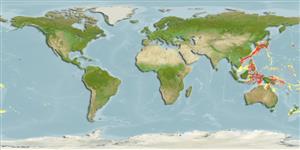Actinopterygii (ray-finned fishes) >
Stomiiformes (Lightfishes and dragonfishes) >
Sternoptychidae (Marine hatchetfishes) > Sternoptychinae
Etymology: Polyipnus: Greek, poly = a lot of + Greek, ipnos = lanterns. More on author: Fowler.
Environment / Climate / Range
Ecology
Marine; benthopelagic; depth range ? - 1023 m (Ref. 26282). Deep-water, preferred ?
Western Pacific: collected off east coast of the Philippines and in the central Philippine Sea near the Kyushu-Palau Ridge.
Size / Weight / Age
Maturity: Lm ? range ? - ? cm
Max length : 4.0 cm SL male/unsexed; (Ref. 26382)
Short description
Morphology | Morphometrics
Dorsal
soft rays
(total): 10;
Anal
soft rays: 11 - 12. Polyipnus fraseri is distinguished from all other Polyipnus by the presence of a unique posterior preopercular spine, absence of ACA photophores, and only four ACB photophores at SL over 2 cm (Ref. 26382).
Minimum depth from Ref. 58018.
Life cycle and mating behavior
Maturity | Reproduction | Spawning | Eggs | Fecundity | Larvae
Harold, A.S., 1994. A taxonomic revision of the sternoptychid genus Polyipnus (Teleostei: Stomiiformes) with an analysis of phylogenetic relationships. Bull. Mar. Sci. 54(2):428-534. (Ref. 26382)
IUCN Red List Status (Ref. 115185)
CITES (Ref. 94142)
Not Evaluated
Threat to humans
Harmless
Human uses
More information
Common namesSynonymsMetabolismPredatorsEcotoxicologyReproductionMaturitySpawningFecundityEggsEgg development
Age/SizeGrowthLength-weightLength-lengthLength-frequenciesMorphometricsMorphologyLarvaeLarval dynamicsRecruitmentAbundance
ReferencesAquacultureAquaculture profileStrainsGeneticsAllele frequenciesHeritabilityDiseasesProcessingMass conversion
Tools
Special reports
Download XML
Internet sources
